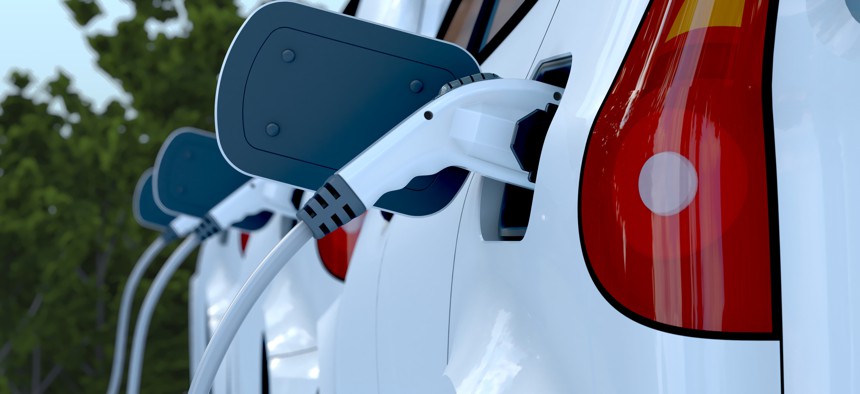One County's Big Plans to Electrify Its Fleet, Build Out Local Charging Network

3alexd/Getty
Orange County, Florida, wants to transition all of vehicles over to electric while also building out its EV changing station network for residents and Disney World visitors.
The Global EV Outlook 2022, published by the International Energy Agency, pegged electric vehicle sales at 6.6 million in 2021, double the amount sold in 2020. And those gains were made despite global supply chain disruptions that severely hindered vehicle manufacturing.
The federal government is a big driver of the EV transition effort. President Biden wants to transition every federal vehicle, which according to the General Services Administration totals 645,000 cars, trucks, mail carrier vans, busses and non-combat military vehicles, over to electric by 2035. He signed an executive order to begin that transformation last year. Many state and local governments are expected to follow up with their own programs, and quite a few were moving in that direction ahead of the federal plan’s announcement.
But what a lot of municipalities are learning is that transitioning over to a fleet of electric vehicles is more involving than just buying a bunch of electric cars and trucks. All of those vehicles will need a place to plug in and recharge.
And if states also want to encourage their citizens to transition over to electric, they will need access to charging stations as well. Ideally, those stations will all have a unified and compatible interface so that any vehicle can power up at any charging station. That is the goal of a recent Federal Highway Administration draft proposal that is now available for comment. The proposal tries to plot a course that would create a unified, nationwide electric vehicle charging system.
One place that is already dealing with these issues is Orange County, Florida. Located in central Florida, it’s ideally suited as an EV charging hub with 1.5 million residents. Orlando is its county seat, and is one of the most popular tourist and business traveler destinations in the country. Millions of people also pass through the county’s many highways, like Interstate 95, which goes right through Orlando. So it may not be surprising that Orange County was already pushing ahead with its electric vehicle transition, and dealing with the complexities of that, ahead of the federal government.
“We are number two in the nation, behind California, in electric vehicle sales,” said Sustainability and Innovation Engagement Specialist for Orange County Government Maeven Rogers. “And as of 2021, Orange County is currently home to the largest inventory of public Electric Vehicle Charging Infrastructure of any county in Florida. Orange County presently exceeds the LEED Credit requirement of 1.07 with a current total of 3.44 EV Charging stations per 10,000 residents.”
One of the reasons that businesses, government and residents of Orange County support EVs is that they are better for the environment.
“An analysis completed by the Sustainability Division of Orange County found that emissions from on-road vehicles accounted for 40% of Orange County's total community-wide emissions,” said Orange County Sustainability Programs Manager Lori Forsman. “Given the expected population growth of the county in the next 30 years of 650,000 or more people, a strategy for reduction of these on-road emissions is necessary and can not only involve a plan to move Orange County's fleet to electric, but also to provide a robust electric vehicle charging infrastructure.”
Even though Orange County has one of the highest densities of electric charging stations in the state, officials realize that more are necessary. The county wants to make sure that visitors traveling to many of its tourist attractions, like Walt Disney World, don’t need to worry about running out of charge in their vehicles.
And also, Florida has a unique geography with both a tropical (in the south) and subtropical (in the north) climate that is sometimes subject to hurricanes and other powerful storms. So, officials need to make sure that residents with EVs can evacuate safely when necessary. That may mean investing heavily in charging stations along designated main travel corridors.
“The county is examining emergency evacuation routes and ways to provide infrastructure along those particular areas that can provide a quick turnaround for longer trips,” Rogers said. “This also gives millions of visitors to our region the confidence they need to travel without range concerns, meaning running out of battery. All these items are being looked at and incorporated into Orange County's Vision 2050 Plan, expected to be published in the summer of 2023.”
Like the federal government, Orange County wants to eventually transition all of its government vehicles over to electric. Although global supply chain disruptions make that goal nearly impossible for now, official say they are pushing ahead as much as possible.
“Our current commitment is to transition 100% of Orange County’s light-duty fleets to electric or alternatives by 2030, accounting for roughly 12% of the County’s fleet vehicles,” Forsman said. “Orange County also has a goal to install an additional 25 electric vehicle charging stations across county-hosted facilities in the next three years, adding to our 2019 baseline of 40, which will account for a total of 65 electric charging stations across county-owned properties by 2030.”
Bigger electric vehicles may soon follow the light-duty cars and trucks, along with increased charging and infrastructure needs. “Orange County Public Schools are awaiting six electric buses awarded by Volkswagen and have applied to the EPA’s Clean School Bus Program, hoping to increase the number in their fleet,” Rogers said. “In addition, our partners over at LYNX, a bus system running throughout the Central Florida Region, are currently exploring more ways to become zero-emission, and already have some electric buses in their current fleet. These are a few impressive projects now taking place with other partners offering and exploring alternatives across the Central Florida Region.”
According to the CEO of Driivz, Doron Frenkel, some of the challenges being overcome in Florida can act as a roadmap for the federal government, which will soon be facing similar situations on a much larger scale. Driivz works with EV companies and organizations to help streamline and scale their charging infrastructure, and to unify it like the Federal Highway Administration draft plan outlines. The Driivz operating system currently manages over 100,000 EV chargers around the country.
According to Frenkel, the key to government success in transitioning over their entire fleet of vehicles to electric will be intricate planning for their charging infrastructure.
“Planning this transition requires a clear definition of the long-term fleet strategy and a clear understanding of the fleet charging and energy requirements,” Frenkel said. “For day-to-day planning, fleet and facility managers, along with drivers, will need easy-to-use scheduling tools that can predict the distance each EV will travel, evaluate their charging patterns and dwell time, and plan accordingly. This will give federal fleet managers a good understanding of how much energy the depot site will require when the charger load is at maximum.”
Even after the federal charging infrastructure is put in place, more planning will be required to make the whole system as efficient as possible. “A big part of the financial benefits of an electric fleet will only be achieved when the fleet can participate in a flexible energy market that can shift energy between vehicle batteries and generation, especially renewables and off-peak pricing,” Frenkel added. “This requires smart planning and energy prediction as well as bi-directional vehicle-to-grid integration.”
Adding to the complexity of building out a nationwide charging infrastructure for the federal government is the fact that not all chargers are equal. According to Frenkel, the common L2 chargers in use at many places today can charge at a rate of 19 kilowatts, and can take hours to fully fill a vehicle’s battery. That is a key reason why most charging these days takes place at homes or people’s workplaces, where the vehicles can sit for hours while their drivers do other things. Some more advanced chargers support 50 all the way up to 350 kilowatt charging. At the high end, those can charge up a vehicle in just seven minutes. There are tradeoffs however, with faster chargers pulling even more power from already stressed grids and infrastructure.
“McKinsey Research believes that unmanaged, substation peak-load increases from EV-charging power demand will eventually push local transformers beyond their capacity, requiring expensive infrastructure upgrades,” Frenkel said. And that is something that the federal government as well as many local municipalities may need to address.
Frenkel believes that even a complex problem like supporting a growing EV charging infrastructure is solvable. He suggested several areas that government could consider. They include:
- Optimizing the charging infrastructure by efficiently distributing the available power. For example, smart energy management can shift charging loads based on dynamic grid and renewable supplies, preconfigured policies and the needs of vehicle owners. In other words, it ensures that the right amount of energy gets to the right resource at the right time.
- Enhancing the power grid may be necessary, although this is expensive and can take up to a year to complete within each area.
- Adding local battery storage devices can supplement the power grid, storing energy from renewable sources and using it to help charge EVs when needed.
- Adding local energy generation closer to the edge where the chargers are being used can take some of the load off of the overall grid.
In addition to those key steps, Frenkel says that the government is in a unique position to incentivize power providers using regulations, rewards and policies to help make sure that the charging infrastructure grows alongside of the surge in EV usage. And although it may seem like there are quite a few obstacles to a full EV transition, Frenkel is confident that the government’s goals with EVs are fully achievable with good planning.
John Breeden II is an award-winning journalist and reviewer with over 20 years of experience covering technology. He is the CEO of the Tech Writers Bureau, a group that creates technological thought leadership content for organizations of all sizes. Twitter: @LabGuys






